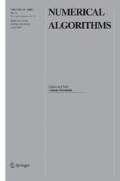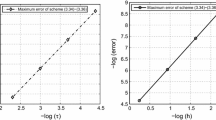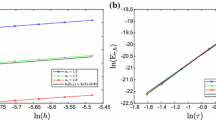Abstract
The paper is devoted to the construction of high-precision unconditionally stable finite difference methods for solving time-space fractional diffusion equation with the Caputo fractional derivative (of order β, with β ∈ (0, 1)) in time and the Rimann-Liouville fractional derivatives (of order α, with α ∈ (1, 2]) in space. Two kinds of difference schemes with the approximation orders O(τ2−β + h3) and O(τ2 + h3) respectively are constructed. The stability and convergence are analyzed in detail. The obtained results are illustrated numerically by some examples, and a comparative study of several high-order schemes is also carried out.
Similar content being viewed by others
References
Deng, W.H., Li, C.P.: The evolution of chaotic dynamics for fractional unified system. Phys. Lett. A 372, 401–407 (2008)
Scalas, E., Gorenflo, R., Mainardi, F.: Fractional calculus and continuous time finance. Physica A 284, 376–384 (2000)
Benson, D.A., Wheatcraft, S.W., Meerschaert, M.M.: Application of a fractional advection-dispersion equation. Water Resources Res. 36, 1403–1412 (2000)
Sun, H.G., Zhang, Y., Baleanu, D., Chen, W., Chen, Y.Q.: A new collection of real world applications of fractional calculus in science and engineering. Commun. Nonlinear Sci. Numer. Simulat. 64, 213–231 (2018)
Gorenflo, R., Mainardi, F., Moretti, D., Pagnini, G., Paradisi, P.: Fractional diffusion: probability distributions and random walk models. Physica A 305, 106–112 (2002)
Chen, W.: TimeCspace fabric underlying anomalous diffusion. Chaos, Soliton. Fract. 28, 923–929 (2006)
Podlubny, I.: Fractional Differential Equations. Academic Press, New York (1999)
Magin, R.L., Abdullah, O., Baleanu, D., Zhou, X.J.: Anomalous diffusion expressed through fractional order differential operators in the Bloch-Torrey equation. J. of Mag. Res. 190, 255–270 (2008)
Liu, F., Zhuang, P., Anh, V., Turner, I.: A fractional-order implicit difference approximation for the space-time fractional diffusion equation. ANZIAM J. 47, C48-C68 (2006)
Yang, Q., Turner, I., Liu, F., Ili’c, M.: Novel numerical methods for solving the time-space fractional diffusion equation in two dimensions. SIAM J. Sci. Comput. 33, 1159–1180 (2011)
Wang, Z., Vong, S.K., Lei, S.L.: Finite difference schemes for two-dimensional time-space fractional differential equations. Int. J. Comput. Math. 93, 578–595 (2016)
Chen, M.H., Deng, W.H.: A second-order accurate numerical method for the space-time tempered fractional diffusion-wave equation. Appl. Math. Lett. 68, 87–93 (2017)
Pang, H., Sun, H.: Fourth order finite difference schemes for time-space fractional sub-diffusion equations. Comput. Math. Appl. 71, 1287–1302 (2016)
Langlands, T.A.M., Henry, B.I.: The accuracy and stability of an implicit solution method for the fractional diffusion equation. J. Comput. Phys. 205, 719–736 (2005)
Cui, M.R.: Compact alternating direction implicit method for two-dimensional time fractional diffusion equation. J. Comput. Phys. 231, 2621–2633 (2012)
Ren, J.C., Sun, Z.Z., Zhao, X.: Compact difference scheme for the fractional sub-diffusion equation with Neumann boundary conditions. J. Comput. Phys. 232, 456–467 (2013)
Zhai, S.Y., Weng, Z.F., Gui, D.W., Feng, X.L.: High-order compact operator splitting method for three-dimensional fractional equation with subdiffusion. Int. J. Heat Mass Transfer 84, 440–447 (2015)
Zhai, S.Y., Feng, X.L.: A block-centered finite-difference method for the time-fractional diffusion equation on nonuniform grids. Numer. Heat Transfer B 69, 217–233 (2016)
Hao, Z.P., Sun, Z.Z., Cao, W.R.: A fourth-order approximation of fractional derivatives with its applications. J. Comput. Phys. 281, 787–805 (2015)
Vong, S., Lyu, P., Chen, X., Lei, S.-L.: High order finite difference method for time-space fractional differential equations with Caputo and Riemann-Liouville derivatives. Numer Algorithms 72, 195–210 (2016)
Alikhanov, A.A.: A new difference scheme for the time fractional diffusion equation. J. Comput. Phys. 280, 424–438 (2015)
Tian, W.Y., Zhou, H., Deng, W.H.: A class of second order difference approximations for solving space fractional diffusion equations. Math. Comp. 84, 1703–1727 (2015)
Zhou, H., Tian, W.Y., Deng, W.H.: Quasi-compact finite difference schemes for space fractional diffusion equations. J. Sci. Comput. 56, 45–66 (2013)
Ding, H.F., Li, C.P.: High-order numerical algorithms for Riesz derivatives via constructing new generating functions. J. Sci. Comput. 71, 759–784 (2017)
Ding, H.F., Li, C.P.: High-order algorithms for Riesz derivative and their applications (III). Fract. Calc. Appl. Anal. 19, 19–55 (2016)
Wang, Z.B., Vong, S.W.: Compact difference schemes for the modified anomalous fractional sub-diffusion equation and the fractional diffusion-wave equation. J. Comput. Phys. 277, 1–15 (2014)
Gao, G.H., Sun, H.W., Sun, Z.Z.: Stability and convergence of finite difference schemes for a class of time-fractional sub-diffusion equations based on certain superconvergence. J. Comput. Phys. 280, 510–528 (2015)
Zhai, S.Y., Feng, X.L.: Investigations on several compact ADI methods for the 2D time fractional diffusion equation. Numer Heat Transfer B 69, 364–376 (2016)
Dimitrov, Y.: Numerical approximations for fractional differential equations. arXiv:1311.3935v1 (2013)
Chan, R.H., Jin, X.Q.: An introduction to iterative toeplitz solvers, SIAM (2007)
Chan, R.H.: Toeplitz preconditioners for Toeplitz systems with nonnegative generating functions. IMA J. Numer. Anal. 11, 333–345 (1991)
Quarteroni, A., Sacco, R., Saleri, F.: Numerical Mathematics, 2nd ed. Springer (2007)
Laub, A.J.: Matrix Analysis for Scientists and Engineers, SIAM (2005)
Zeng, F.H., Li, C.P., Liu, F.W., Turner, I.: Numerical algorithms for time-fractional subdiffusion equation with second-order accuracy. SIAM J. Sci. Comput. 37, A55-A78 (2015)
Zhao, X., Sun, Z.Z., Hao, Z.P.: A fourth-order compact ADI scheme for two-dimensional nonlinear space fractional schrödinger equation. SIAM J. Sci. Comput. 36, A2865-A2886 (2014)
Zhai, S.Y., Feng, X.L., He, Y.N.: An unconditionally stable compact ADI method for three-dimensional time-fractional convection-diffusion equation. J. Comput. Phys. 269, 138–155 (2014)
Acknowledgements
Authors thank the editor and referees for their constructive comments and useful suggestions which improved greatly the quality of our paper.
Funding
The work was partially supported by the CAPES and CNPq, Brazil; the NSF of China (Nos. 1701196, 11701197); the China Postdoctoral Sustentation Fund; the Natural Science Foundation of Fujian Province (No. 2016J05007); the Natural Science Foundation of Xinjiang Province (No. 2016D01C07) and the Promotion Program for Young and Middle-aged Teacher in Science and Technology Research of Huaqiao University (ZQN-YX502), China.
Author information
Authors and Affiliations
Corresponding author
Appendix
Appendix
In this appendix, we present the proof of h(α; x) ≤ 0. Thus, we list the following lemma.
Lemma A.1
For anyx ∈ [0,π] andα ∈ (1, 2), we haveh(α; x) decreases withrespect toα,that is
Proof
Taking the partial derivative of h(α, x) with respect to α, we have
where
with \(A=\frac {\alpha (x-\pi )}{2}-x\).
Next, we estimate Eq. 28 via the following two steps.
- I: :
-
We first consider L1(α; x) ≤ 0. It is easy to obtain
$$ L_{1}(\alpha,x)=\frac{6\alpha-13}{12}\cos(A)\cos(x)+\frac{1}{2}\sin(A)\sin(x)+\frac{-6\alpha+ 13}{12}\cos(A). $$(2)For any x ∈ [π/2,π] and α ∈ (1, 2), it is obviously L1(α; x) ≤ 0.
For any x ∈ [0,π/2) and α ∈ (1, 2), since
$$\frac{\partial}{\partial x}\left[\frac{6\alpha-13}{12}\cos A\cos x+\frac{1}{2}\sin A\sin x\right]\leq 0,$$we have
$$\frac{6\alpha-13}{12}\cos A\cos x+\frac{1}{2}\sin A\sin x\leq \frac{6\alpha-13}{12}\cos \left( -\frac{\alpha\pi}{2}\right), $$and combining with
$$\frac{-6\alpha+ 13}{12}\cos A\leq\frac{-6\alpha+ 13}{12}\cos\left( \frac{-\alpha\pi}{2}\right),$$so we obtain L1(α; x) ≤ 0.
- II: :
-
We now consider L2(α; x) ≤ 0. It is easy to obtain
$$ L_{2}(\alpha; x)=\frac{3\alpha^{2}-7\alpha}{12}\sin A\cos x+\frac{2-\alpha}{2}\sin\left( \frac{\alpha(x-\pi)}{2}\right)+\frac{-3\alpha^{2}+ 13\alpha}{12}\sin(A). $$(3)For any x ∈ [π/2,π] and α ∈ (1, 2), it is obviously L2(α; x) ≤ 0.
For any x ∈ [0,π/2) and α ∈ (1, 2), we have
$$\begin{array}{@{}rcl@{}} L_{2}(\alpha; x)&=&\frac{3\alpha^{2}-7\alpha}{12}\sin A\cos x+\frac{2-\alpha}{2}\sin(A+x)+\frac{-3\alpha^{2}+ 13\alpha}{12}\sin(A)\\ &=&\frac{3\alpha^{2}-13\alpha}{12}\sin A(\cos x-1)+\sin A\cos x+\frac{2-\alpha}{2}\cos A\cos x\\ &\leq& 0. \end{array} $$
As a result of (I) and (II), we obtain the expected result.□
Rights and permissions
About this article
Cite this article
Zhai, S., Weng, Z., Feng, X. et al. Investigations on several high-order ADI methods for time-space fractional diffusion equation. Numer Algor 82, 69–106 (2019). https://doi.org/10.1007/s11075-018-0594-z
Received:
Accepted:
Published:
Issue Date:
DOI: https://doi.org/10.1007/s11075-018-0594-z




